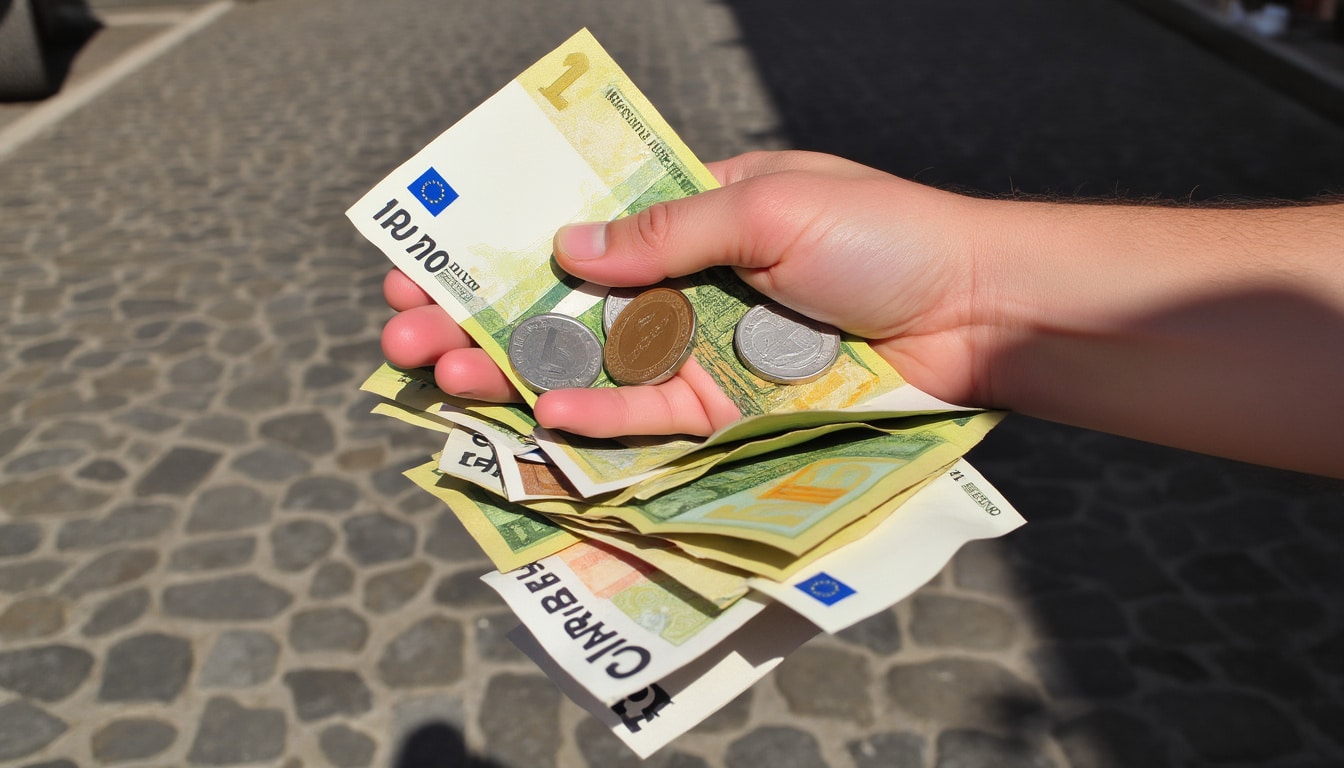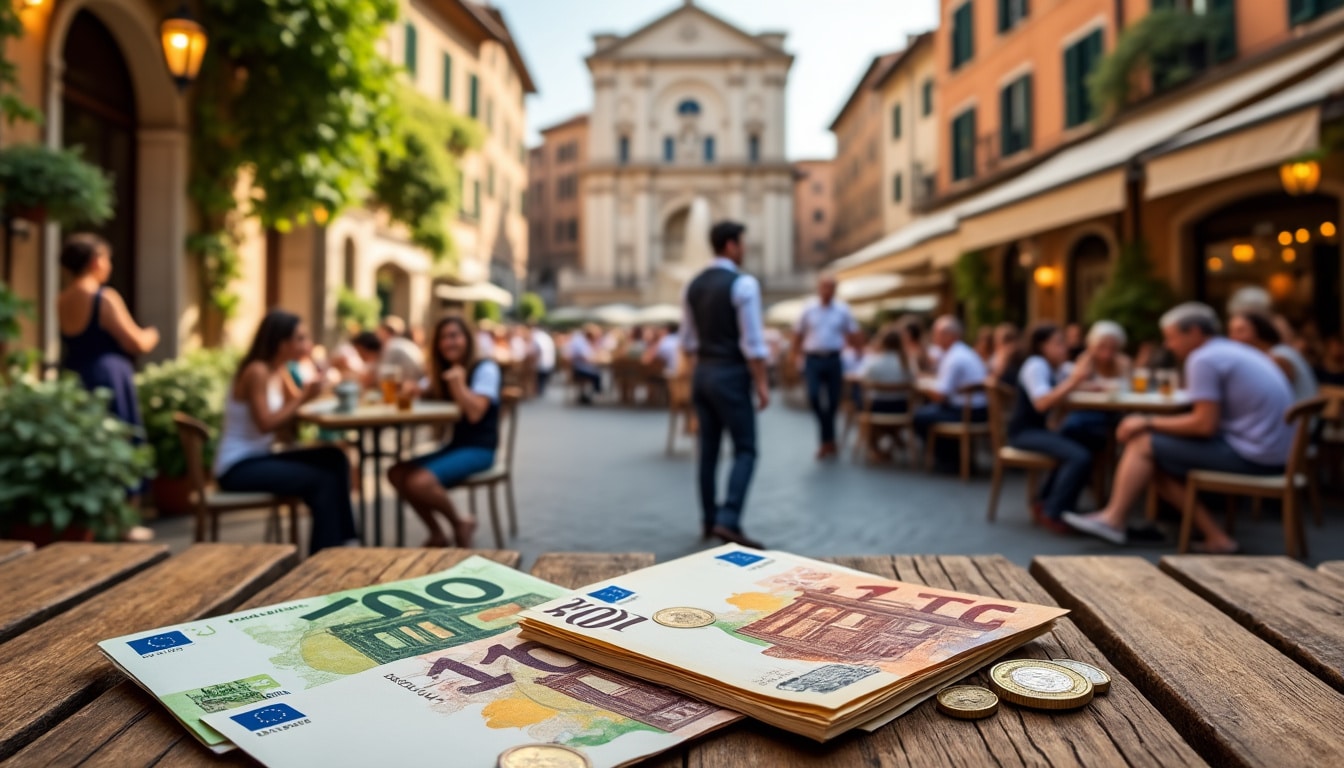Rome, the Eternal City, attracts millions of travelers each year, drawn by its rich history, awe-inspiring architecture, and vibrant culture. However, when it comes to navigating the practical aspects of your visit, such as currency and tipping etiquette, understanding the local norms can significantly enhance your experience. This guide offers a comprehensive look at handling money matters in Rome, from the ins and outs of using the Euro, to navigating the tipping culture, ensuring you feel confident and prepared for your Roman adventures.
Understanding the Euro: Rome’s Currency Explained
As the bustling capital of Italy, Rome operates on the Euro (€), the official currency of the Eurozone, which includes 19 of the 27 European Union countries. Since adopting the Euro in 2002, Italy has streamlined transactions not only in its domestic economy but also with the neighboring nations. When you travel to Rome, understanding the most efficient ways to manage and use the Euro can elevate your comfort and financial savvy in the city.
One crucial aspect of handling Euros effectively is understanding the various denominations and the practicalities of currency exchange. Euros come in bills of €5, €10, €20, €50, €100, €200, and €500, while coins range from 1 cent to 2 Euros. For tourists, obtaining Euros before you arrive is often wise; this means you can hit the ground running the moment you step off the plane. Consider withdrawing Euros from an ATM machine upon arrival, as it typically offers a more favorable exchange rate than currency exchange services.
It’s important to note that while exchanging money at airports is convenient, it can come at a cost—higher fees or less favorable rates. Thus, using bank-affiliated ATM machines, found ubiquitously throughout Rome, is a reliable option. For those planning longer stays or frequent travels to Europe, using a Wise Multi-Currency Card could prove advantageous, allowing you to convert and manage funds with low fees.

Moreover, cash is king in many smaller transactions, especially in local markets or trattories, where card payments might not be accepted. Familiarity with the local currency ensures smooth transitions, whether you are indulging in exquisite Italian gelato or buying a fountain pen as a souvenir from one of Rome’s charming boutiques.
Currency Exchange Services vs. ATMs
When it comes to exchanging your home currency for Euros, travelers may consider currency exchange services or utilizing bank ATMs. Currency exchange counters are often available in airports, city centers, and hotels, but they might charge high fees or provide less competitive exchange rates. On the other hand, bank ATMs can offer the most favorable rates. These machines are scattered across the city, providing convenient access to cash when needed.
An additional tip is to always opt for transactions in Euros rather than your home currency to avoid poor conversion rates imposed by dynamic currency conversion. This prudent choice during any transaction will help keep unnecessary costs at bay during your Roman escapade.
Tipping Etiquette in Rome: Do’s and Don’ts
Navigating tipping culture in Rome can be a subtle art, requiring a bit of finesse and understanding of local customs. Unlike in the United States, where tipping can account for a substantial portion of earnings in the service industry, tipping in Rome is appreciated as a gesture of goodwill but not seen as obligatory.
The crucial thing to remember is that the level of service dictates the tip rather than the expectation of it being a significant percentage of the bill. Most locals might leave some small change or round up the bill, especially in a trattoria or coffee shop. For instance, if the bill at an Italian restaurant is €28, leaving €30 could be seen as a generous gesture, though it’s not compulsory.
- ✅ In restaurants, a tip of up to 10% is appreciated for outstanding service.
- ✅ At cafes or for gelato, rounding up to the nearest Euro or leaving €1-2 is appropriate.
- ❌ Tipping is not expected for services like getting a coffee at a bar counter.
When dining out, always check your bill. It may include a servizio charge, essentially a service fee. This fee often supplants the need for additional tipping. However, the coperto, a cover charge for bread and table setting, does not include a tip. Understanding these nuances helps avoid unnecessary tipping or etiquette blunders.
Hotels and Taxis: When and How Much?
When staying at hotels, tipping is less common, as costs often include service fees. Nevertheless, if someone goes out of their way, a tip is always appreciated. Housekeepers might enjoy €1-2 per day, while porters may receive €1-2 per bag. As you check out, a gesture of leaving a few Euros at the reception desk reflects your appreciation for excellent service during your stay.
Regarding taxis and ride-shares like Rome cabs, tipping isn’t expected but remains a friendly acknowledgment for extraordinary service. Rounding up to the next Euro or leaving some spare change is a common practice.
Practical Scenarios: Understanding When to Tip in Rome
Handling everyday transactions in this enchanting city involves recognizing when a tip can enhance your experience and show respect for excellent service. Whether you are indulging in the city’s gastronomic delights, using transportation services, or enjoying guided tours, knowing when a tip is appropriate can spare you from unintentionally offending or overcompensating, preserving your travel budget.
In a typical restaurant or trattoria, a 5-10% tip could be seen as lavish for a delightful meal, reflecting satisfaction with the service provided. Still, if it’s a quick espresso or sandwich grabbed while sightseeing, the words “grazie mille” suffice.
- 🚌 Tour guides: A tip of €5-10 per person for an exceptional tour is well-received.
- 🚖 Cabs: Rounding up the fare or offering a bit extra for help with luggage is welcomed.
- 🏨 Hotel staff: Small tips can be left for extraordinary help during your stay.
Understanding local norms redefines your interaction with hospitality services and enhances your cultural experience, enabling you to act more like a savvy local than a wide-eyed tourist.
Local Spots and Tipping Considerations
While in Rome, you will undoubtedly visit both high-end and quaint local spots, each with its expectations regarding tips. Upscale restaurants or bars may expect closer adherence to international tipping norms. In contrast, smaller neighborhood eateries often require no extra compensation but appreciate any acknowledgment of stellar service.
Navigating Cash vs. Card Payments in Rome
In the digital age, visitors often wonder whether to rely on cash or card payments during their stay in Rome. Though cards are widely accepted, numerous small businesses and local vendors still rely heavily on cash transactions. Cautious planning regarding knowing when to use each payment method saves time and potential hassle.
For larger purchases or at prominent establishments like hotels and larger restaurants, using a card is convenient and typically hassle-free. However, remember that tips can’t usually be added to card payments, so maintaining a small reserve of Euros for such situations proves practical.
- 💳 Tips are often given in cash, even if the main bill is settled by card.
- 🏧 ATM machines are widely accessible, making it easy to withdraw Euros as needed.
- 📉 Avoid dynamic currency conversion fees by choosing to pay in Euros.
When Cash is Preferable
In markets, family-run trattorias, and street vendors selling everything from gelato to souvenirs, cash is preferred. This preference allows you to engage instantly without the worry of technical card issues or additional charges.
The Cultural Significance of Tipping in Rome
Tipping is not merely a transactional gesture in Rome but an interaction steeped in cultural history. As a society that prizes hospitality, Italians see tipping as a nod to gratitude rather than obligation. Delving into the cultural mindset of Rome’s residents offers a richer appreciation of the nuances behind gratuity exchanges in everyday transactions.
This cultural perspective means that tipping reflects the relationship between the provider and receiver and an acknowledgment of life’s small pleasures. Engaging in customary practices showcases respect and understanding, making your journey through Rome not just a touristic visit but a gratifying cultural immersion.
- 🏛️ Connect with Roman traditions by showing appreciation through customary tipping.
- 🛍️ Enhance shopping experiences by familiarizing yourself with local customs.
- 🍷 At wine bars, tipping might complement delightful wine-tasting experiences.
This guide to currency and tipping etiquette aims to prepare you for a smooth and culturally enriched visit to Rome, enhancing both practical and social aspects of your travel experiences.
FAQs about Currency and Tipping in Rome
Q: Can I tip in US dollars while in Rome?
A: It’s advisable to tip in Euros, as local currency is preferred, preventing potential loss in conversion fees for the recipients.
Q: Are there apps or cards that help manage currency and conversions?
A: Yes, many travelers use apps like the Wise Multi-Currency Card to manage conversions easily and pay with minimal fees while abroad.
Q: Is it considered rude to not leave a tip in Rome?
A: Not necessarily. While tips are appreciated, they’re not expected. Leaving a gratuity is more about appreciation than obligation.
Q: What’s the best way to calculate a fair tip?
A: For restaurants, aiming for 5-10% is a good guide, depending on the service quality.
Q: Should I tip taxi drivers during short trips?
A: While it’s not mandatory, rounding up your fare slightly is seen as a polite gesture.

